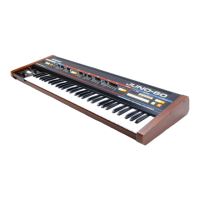17
The
variation of each
knob.
Attack Time
Setting
of
ADSR and
Envelope
Curve.
V
Time
(sec)
Decay Time
and
Release
Time
A
55
Time (sec)-L
Sustain Level
I
^
I
Voltage
*
in the
figure
shown above,
the
positions of
the
knobs are not
meant
to be exactly
correct,
so
the knob position does not necessarily
cor-
respond with the time and the voltage.
••When ail of the ADSR sliders are
set to
zero, the waveform
will be an extremely
short Pulse wave, and only
a short "click"
ts heard. Please be careful.
LFO
(Low
Frequency Oscillator)
This
oscillator generates only low
frequency
signal. It
controls the VCO and the VCF to
produce
vibrato and growl effects.
peuar TWO
MTX vm.
MODE
©
®
©
RATE
knob
This adjusts the rate of LFO.
®
TRIG
MODE
•TRIGGER
MODE
switch
You can
select whether to operate the LFO
manually or automatically.
®
DELAY
TIME
knob
This sets
the
time
needed for the LFO to
start
to
function. The function varies
depending
on the position of the
TRIGGER MODE
switch®.
^""^-^TRIG
MODE
DELAY
TIME^^^^
AUTO
Or
Or
MANUAL
em
—
a
J*
m
ii
^
o
LFO always functions.
The
LFO
works
while
the
LFO TRIGGER
button
is
being
pressed
,
and stops
when
the
button is
released.
KJ
Tlm.
=
Other than
The
LFO
does
not start to
function
until
the
Delay Time
set
with the DELAY TIME
has passed.
(*}
While
the
TRIGGER
button
is being pressed,
the
LFO
amplitude
becomes
larger.
When the delay
time
set pre-
viously has passed,
it
becomes
norma!
amplitude.
This Delay
function works only
in non-
legato
manner.
So
the Delay Time
affects
only
the first key in
a
legato
section.

